Plastics have become ubiquitous throughout the global economy and in our daily lives as a result of their useful properties and low cost. At the same time, the durability of plastics combined with poor waste management has resulted in an estimated 60% of all plastics ever produced accumulating in landfills and the environment, where they can last for hundreds of years. As plastics break down, they form microplastics – tiny plastic pieces. Microplastics can accumulate persistent pollutants while they circulate in the marine environment and can enter the human food chain through seafood, sea salt and drinking water. Because ocean currents distribute lightweight plastic debris far from its source, the environmental quality of one nation can be negatively impacted by plastic litter originating from other nations.
Strategies being deployed around the world to curb plastic waste and marine plastic pollution include:
As is the case in many countries, Canada’s largest single category of plastic waste is packaging. The increasing volume of single-use plastics, including plastic packaging, is problematic as these products are only used briefly, rarely recycled and prone to becoming litter. The majority of Canada’s plastic waste ends up in landfills, with only 9% being recycled. Recycling plastic waste is often not the most economical choice due to a number of factors: contamination of plastics sent for recycling, logistical challenges in sorting various types of plastic; the inclusion of hard-to-recycle plastics in the waste stream; the use of dyes and additives in plastics, which limits the use of recycled resin; limited markets for recycled plastics; and the low cost of petroleum products used in manufacturing conventional new plastics.
As a contributor to the global problem of marine plastic pollution, Canada has a role in addressing its root causes. Canada used its Group of Seven presidency in 2018 to advance the Ocean Plastics Charter, which promotes cooperation among governments and businesses and contains targets to reduce the flow of plastics to the environment. Prevention is key: reducing the amount of plastic waste generated in the first place is the preferred approach in the Canada-wide Action Plan on Zero Plastic Waste – Phase 1.
Images of the world’s oceans strewn with plastic pollution, and of landfills piled high with plastic waste, have raised public concern. It is, perhaps, especially concerning when single-use plastics and packaging – used only for a short time before being discarded – can go on to harm wildlife and pollute the environment for hundreds of years.1 In a 2019 survey, 87.2% of Canadian respondents considered the environmental impact of single-use plastic food packaging to be important.2
Plastics are now integrated throughout the global economy and our daily lives. Unfortunately, they are also found throughout the environment. Environment and Climate Change Canada reports that plastic litter is now found on all of Canada’s marine coasts and freshwater areas, including the Great Lakes.3 To address plastic waste and pollution, Canada is implementing the Canada-wide Action Plan on Zero Plastic Waste – Phase 14 and is developing Phase 2 of this plan. Canada joins other nations and organizations in taking action to reduce leakage of plastic into the environment. Since there are many global stakeholders5 in the life cycle of plastic products, a range of policy solutions and international collaboration will likely be required to substantially reduce plastic pollution.
To understand the issue of global plastic pollution, it is helpful consider the reasons behind the growth in the use of plastics and of the generation of plastic waste. This section of the paper addresses the characteristics of plastics that contributed to a behavioural shift away from the use of traditional materials (e.g., paper, glass, metal) towards the use of plastics. The section also describes some of the issues with recycling and composting plastics that contribute to the generation of plastic waste. The fate of plastic litter once it enters the marine environment is also discussed.
The production and use of plastics have grown dramatically since widescale production began in the 1950s, due to their low cost and useful properties.6 Plastic resins offer combinations of beneficial properties that other materials may not provide, such as insulation, flexibility and resistance to high temperatures, chemicals and shattering.7 The low cost of plastics enabled the proliferation of single-use plastic products, which are disposed of after use. In health care, single-use plastic products have enabled innovation and decreased risk of cross-contamination.8 Plastic packaging in the food industry has reduced food spoilage with its associated greenhouse gas (GHG) emissions, while plastics used in place of heavier alternatives reduce the fuel required for transportation.9
Due to the durability of plastics and their low recycling rate, it is estimated that 60% of the plastics ever produced have accumulated in landfills or the environment.10 If current trends in per capita plastics use continue, plastic production is projected to increase exponentially through 2050 (Figure 1). Without policy or behavioural shifts in the treatment of plastic waste, the majority of the plastic waste generated will continue to accumulate as landfill liabilities and pollution.
Figure 1 – Historical and Projected Global Plastic Production with Inset Map Showing Total Plastic Production by Region
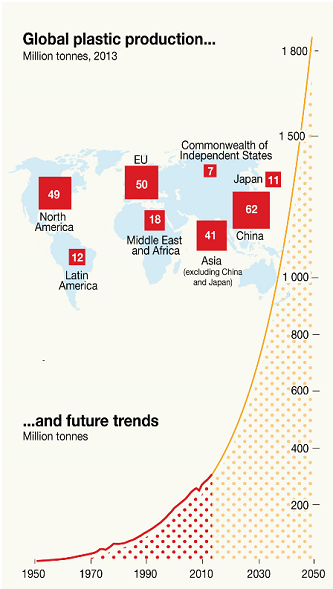
Source: UN Environment and GRID-Arendal, “Global plastic production and future trends,” in Marine Litter Vital Graphics, Joan Fabres et al. (eds.), 2018. Infographic prepared by Maphoto/Riccardo Pravettoni, adapted from Peter G. Ryan, “A Brief History of Marine Litter Research,” Chapter 1 in Marine Anthropogenic Litter ![]() (8.96 MB, 456 pages), Melanie Bergmann, Lars Gutow and Michael Klages (eds.), Springer, Berlin, 2015; and Plastics Europe, Plastics – the Facts 2013: An analysis of European latest plastics production, demand and waste data
(8.96 MB, 456 pages), Melanie Bergmann, Lars Gutow and Michael Klages (eds.), Springer, Berlin, 2015; and Plastics Europe, Plastics – the Facts 2013: An analysis of European latest plastics production, demand and waste data ![]() (935 KB, 40 pages).
(935 KB, 40 pages).
Although reports of the ecological impacts of plastic waste first appeared in the scientific literature in the 1960s, marine plastic pollution only came to widespread public attention after the publicization of the “Great Pacific Garbage Patch” in the late 1990s.11 Ocean currents distribute floating plastic debris and cause it to accumulate in certain areas, such as in the North Pacific, as shown in Figure 2.
Figure 2 – Global Ocean Currents and Their Effect on the Distribution and Accumulation of Marine Microplastic Debris
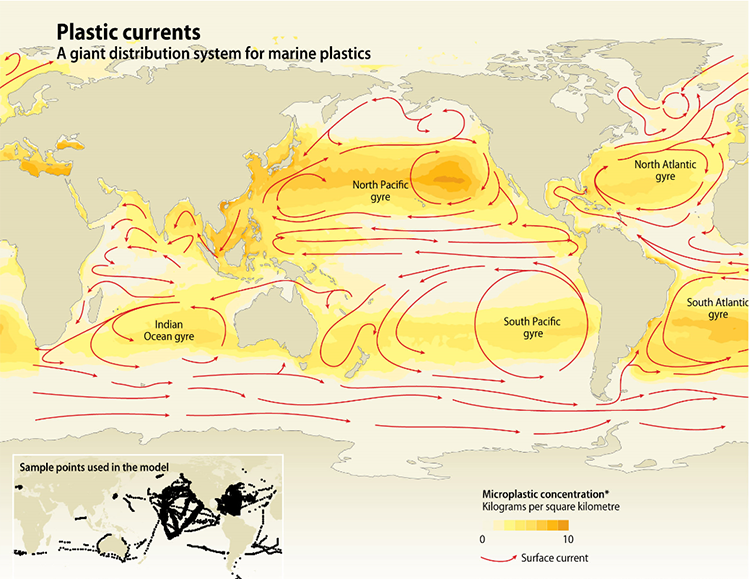
Note: A gyre is a circular oceanic surface current. Microplastics are plastic items measuring less than 5 mm.
Source: UN Environment and GRID-Arendal, “Plastic currents,” in Marine Litter Vital Graphics, Joan Fabres et al. (eds.), 2018. Infographic by Maphoto/Riccardo Pravettoni, based on Erik van Sebille et al., “A global inventory of small floating plastic debris,” IOP Science, 8 December 2015; and Cooperative Institute for Meteorological Studies.
By ingesting plastics or becoming entangled in plastic debris, marine and coastal wildlife may be harmed or killed.12 Marine plastic debris also negatively impacts the coastal tourism, recreation, shipping and fishing sectors.13 Since ocean plastics from one country can easily be circulated to impact the shores and wildlife of other countries, marine plastic pollution is a transboundary issue.14
Inadequate land-based plastic waste management is responsible for about 80% of plastic litter in marine environments, including unmanaged dumps, intentional littering, and windblown lightweight plastics escaping recycling and garbage bins.15 Plastic waste that is swept away by rivers can eventually find its way to the ocean.16 Lost or abandoned plastic fishing gear and dumping at sea are also sources of marine plastic pollution.17 Plastic debris is projected to last for hundreds of years, depending on the type of resin and environmental conditions.18
It is estimated that between 4.8 million tonnes and 12.7 million tonnes of plastics enter the world’s oceans annually.19 Scientists obtained this estimate by developing a model that used global data on populations living within 50 km of a marine coast, per capita plastic waste generation and percentage of mismanaged plastic waste. When this model was used to evaluate potential marine plastic pollution mitigation strategies, it showed that investments in improved waste management infrastructure in developing countries, along with reduced plastic waste generation from industrialized countries, could greatly reduce the amount of plastic waste entering the ocean.20
“Microplastics” are plastic items measuring less than 5 mm.21 “Primary microplastics” were manufactured to that size (e.g., plastic microbeads), whereas “secondary microplastics” result from the breakdown of larger plastic items.22 Microfibres from synthetic clothing in laundry wastewater, tire dust and degrading plastic litter are some of the sources of secondary microplastics.23
Microplastics have been found globally throughout the marine environment.24 As microplastics are of a similar size to some plankton, they are ingested by aquatic organisms, including some that are important to commercial fisheries.25 Some of the ways in which people inadvertently ingest microplastics are through drinking water, seafood, and sea salt.26 Human health and ecological concerns regarding consuming microplastics include the potential transfer of chemical additives in the plastic and persistent pollutants that the microplastics accumulate as they circulate in the marine environment.27 Scientists and research organizations have called for further quality-controlled investigative health studies, as well as large-scale ecological studies, to fill knowledge gaps related to the risks of microplastics.28
In contrast to recycling materials such as glass and aluminum, recycling plastics is complicated by the variety of chemical compositions of plastic resin. Some plastic resin types are more readily recyclable than others. For instance, #1 and #2 plastic bottles are accepted in nearly all recycling programs across Canada.29 Although #6 (polystyrene) plastic – commonly used for coffee cup lids and foam take-out containers - has a recyclable symbol, it is difficult to recycle and Canadian recycling programs do not typically accept it.30
The current low price of oil and gas used to produce conventional new plastic resin means that economics often do not favour plastics recycling or the use of recycled resin.31 In a mixed recycling system, such as a “blue box” program, the need to sort multiple resins and the problem of residual contamination further decrease profitability of mechanical plastics recycling.32 The dyes and additives in plastics for recycling may decrease the value of recycled resin and prevent its use for certain applications with strict quality requirements.33 Chemical recycling, by which chemical processes break plastic polymers back into their building blocks, holds promise in addressing these contaminants, but it is just at the commercialization stage in Canada.34
While most plastics are highly resistant to degradation by microbes, some plastics are designed to be compostable.35 Compostable plastics hold promise, particularly in applications where plastic containers would be difficult to clean for recycling, or where plastics are likely to end up in a waste stream with food.36 However, there is misunderstanding and a lack of standardization around the labels “compostable,” “biodegradable,” and “degradable” that appear on some plastic products.37 Plastics that are compostable under specific conditions in a commercial composting facility may not be fully compostable in the environment or landfill. To ensure that compostable plastics can fully biodegrade in a reasonably short amount of time, consumers need to know how to properly dispose of them and waste managers need know how to treat them.
The United Nations Environment Programme (UNEP) cautioned policy makers that,
until there is an internationally agreed definition of biodegradability (in the marine environment), the adoption of plastic products labelled as ‘biodegradable’ will not bring about a significant decrease either in the quantity of plastics entering the ocean or the risk of physical and chemical impacts on the marine environment.38
A report commissioned by Environment and Climate Change Canada, Economic Study of the Canadian Plastic Industry, Markets and Waste,39 pulled together data from industry, as well as federal, provincial, territorial and municipal levels of government, to provide an overall perspective on Canada’s plastic waste management reality. The following section provides a snapshot of Canadian plastic waste generation and fate at disposal. The issue of exporting plastic waste for recycling is explored, as is jurisdiction over plastic waste in Canada.
In 2016, Canada generated nearly 3.3 million tonnes of plastic waste, of which the largest category – 1.54 million tonnes, or 47% – was packaging (Figure 3).40 Approximately 86% of this plastic waste ended up in landfills; 9% was recycled; 4% was burned for energy; and 1% leaked into the environment as litter (Figure 4).41 Canada’s 9% plastic recycling rate in 2016 is in line with the estimated global recycling rate for all plastic waste ever produced (also 9%).42
Figure 3 – Plastic Waste Produced in Canada, by Sector, 2016 (kilotonnes [kt])
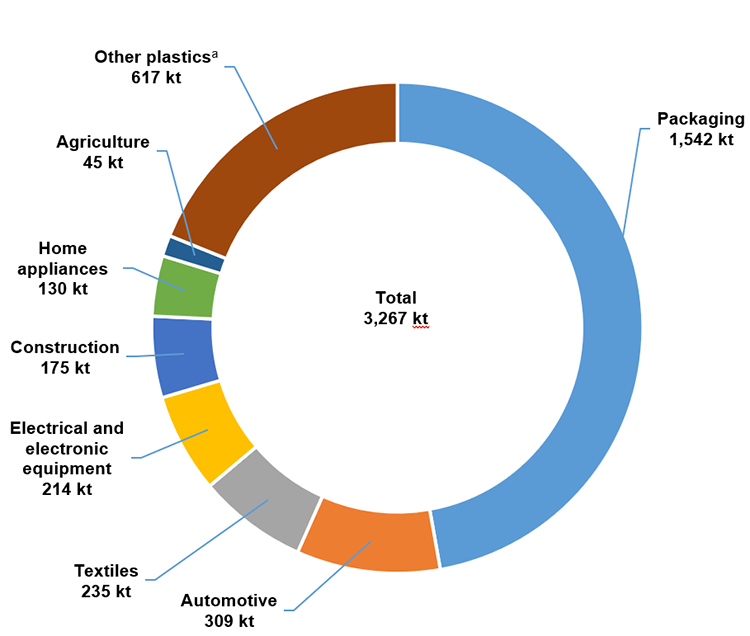
Note:
a. The category “Other plastics” includes plastics used in medical, dental and personal care, toys, household furniture, sporting goods, mattresses, industrial machinery, and chemical products and resins.
Source: Figure prepared by the author using data obtained from Environment and Climate Change Canada, Economic Study of the Canadian Plastic Industry, Markets and Waste: Summary Report to Environment and Climate Change Canada ![]() (4.6 MB, 63 pages), Report prepared for Environment and Climate Change Canada by Deloitte and Cheminfo Services Inc., 2019, pp. 7–8.
(4.6 MB, 63 pages), Report prepared for Environment and Climate Change Canada by Deloitte and Cheminfo Services Inc., 2019, pp. 7–8.
Figure 4 – Destination of Plastic Waste in Canada, 2016 (kilotonnes [kt] and percentage of total)
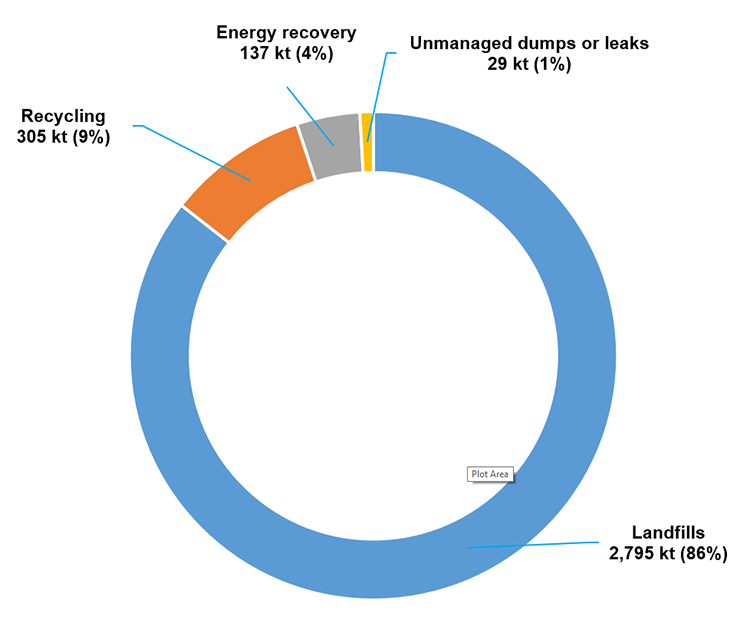
Source: Figure prepared by the author using data obtained from Environment and Climate Change Canada, Economic Study of the Canadian Plastic Industry, Markets and Waste: Summary Report to Environment and Climate Change Canada ![]() (4.6 MB, 63 pages), Report prepared for Environment and Climate Change Canada by Deloitte and Cheminfo Services Inc., 2019, p. 3.
(4.6 MB, 63 pages), Report prepared for Environment and Climate Change Canada by Deloitte and Cheminfo Services Inc., 2019, p. 3.
In Canada, the management of plastic waste is a shared responsibility. In terms of making laws relating to plastic waste, both the Parliament of Canada and provincial/territorial legislatures can legislate on environmental issues in accordance with their respective powers.43 Provincial and territorial governments are primarily responsible for regulating and monitoring waste management facilities, including landfills. Household waste collection and disposal and recycling programs are typically managed by municipal governments, either directly or by industry under contract. Municipalities also establish litter by-laws. The federal government is responsible for the transboundary movement of hazardous waste – including hazardous recyclables – and for preventing toxic substances from entering the environment.44 With multiple levels of government responsible for different aspects of plastic waste management, coordination is important, such as through the Canadian Council of Ministers of the Environment (CCME).
As only 1% of Canada’s plastic waste is leaking into the environment, Canadian shores are not a major global source of marine plastic litter. However, Canada exports plastic waste for recycling to developing countries, as it may not be economic to sort and process it domestically.45 Local waste management standards in the countries receiving these imports might increase the risk of Canadian plastic entering the environment.
In 2018, Canada exported just over 100,000 tonnes of its plastic waste to other countries, which was down from 150,000 tonnes in 2016.46 This marked decrease was mostly due to China adopting higher standards for imported recycling materials, including plastics. When these more stringent contamination standards came into force in 2018, recycling processors in many countries – including Canada – were left searching for new markets, which they subsequently found in other developing countries.47 For instance, Malaysia became the second-biggest destination for this export in 2018: That year, the country imported over 10,000 tonnes of plastic waste from Canada, a tenfold increase from 2016.48
In May 2019, Malaysia announced it would send back 3,000 tonnes of non-recyclable plastic waste to its countries of origin, including Canada.49 Also in May 2019, governments agreed to amend the Basel Convention on the Control of Transboundary Movements of Hazardous Wastes and Their Disposal (Basel Convention) to require the consent of countries when importing mixed and contaminated plastic waste.50 The Basel Convention was originally signed in 1989 out of concern for wastes being exported from industrialized nations for cheap and inadequate disposal in developing countries.51 At the time of writing, Canada had yet to support the May 2019 amendment.52
This section outlines key Canadian initiatives to reduce marine plastic pollution.
A 2014 report prepared for the CCME, State of Waste Management in Canada, concluded that sending plastics to landfill “represents a missed opportunity to extract value from materials in the waste stream.”53 The report identified an opportunity for continued harmonization of plastic material categories to improve diversion from landfill, particularly in smaller Canadian jurisdictions, such as Atlantic Canada and the territories. If plastic recycling labelling and systems were more consistent, the report argued, smaller jurisdictions could establish joint diversion programs “to access economies of scale for program operations, shared infrastructure, and administrative functions.”54
The Strategy on Zero Plastic Waste was approved in principle in November 2018.55 In June 2019, the CCME published the Canada-wide Action Plan on Zero Plastic Waste – Phase 1. As seen in Figure 5, the action plan prioritizes reduction by preventing the generation of plastic waste in the first place. CCME’s least-preferred plastic waste management option – energy recovery – involves converting plastic wastes into liquid or solid fuels to generate heat or electricity through chemical recycling or incineration. Incineration of plastic waste with energy recovery results in GHG emissions and may result in the emission of toxins with environmental and human health consequences, depending on the incinerator’s design, operation and emissions controls.56
Figure 5 – Canadian Council of Ministers of the Environment’s Hierarchy of Priority in Plastic Management
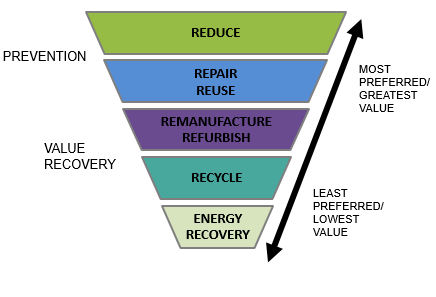
Source: Canadian Council of Ministers of the Environment, Canada-wide Action Plan on Zero Plastic Waste – Phase 1 ![]() (312 KB, 9 pages), 2019, p. 2.
(312 KB, 9 pages), 2019, p. 2.
Phase 1 of the action plan focuses on plastic product design, collection systems and recycling capacity, with specific target dates for the following actions:
In recognition of the beneficial properties of plastics, the action plan states that the overall goal is not zero plastics, but rather plastic reduction and improved plastics life-cycle management.
Phase 2 of the action plan, which is expected to be released in 2020, will focus on the reduction of plastic waste found in Canada’s oceans, the Great Lakes and inland waters, and on research, clean-up, consumer awareness and global action.
The federal government took action to prohibit the manufacture and import of toiletries containing plastic microbeads through the Microbeads in Toiletries Regulations under the Canadian Environmental Protection Act, 1999. As one of only eight countries with national laws or regulations in place to ban these pollutants, Canada is a leader in global efforts to ban microbeads.58 New Zealand has a more robust microbead law, as it not only regulates microbeads in personal care products (as do the other seven countries), but also in abrasive household, car and industrial cleaning products.59
During its Group of Seven presidency in 2018, Canada advanced the Ocean Plastics Charter (Charter). As of 21 November 2019, the Charter had been signed by 21 countries, the European Union (EU), and 64 businesses and organizations.60 The Charter contains commitments regarding the recycling, reuse and recovery of plastics with the goal of halting their flow into the environment. It contains the following targets:
As part of its commitment to the Charter, Canada has promised $100 million to support developing countries in reducing their ocean plastic pollution.61 Such support is particularly important for developing coastal countries whose waste management systems result in high leakage of plastics into the environment.62
Canada is a signatory to a number of international agreements and initiatives that have been developed to reduce marine pollution. Two such examples are the Convention of the Prevention of Marine Pollution by Dumping of Wastes and Other Matter, 1972 and UNEP’s Clean Seas campaign, which seeks to engage governments, the private sector and individuals in efforts to voluntarily reduce the production and consumption of non-recoverable and single-use plastics.63 In March 2019, the fourth session of the UN Environment Assembly achieved a commitment from the ministers of the environment from 157 countries to significantly reduce single-use plastic products by 2030, and to work with the private sector to find affordable and environmentally friendly alternatives.64
UN member states, including Canada, adopted the 2030 Agenda for Sustainable Development in 2015, which centres on a set of Sustainable Development Goals (SDGs).65 UNEP identified several of the SDGs, with their specific targets and indicators, that relate to reducing the inputs and impacts of marine plastic pollution, including the following:
This section highlights some of the efforts of international organizations, other governments and industry to reduce plastic pollution.
The UN has published a number of documents (cited throughout this paper) which provide scientific analysis and policy options related to plastic pollution. In 2018, UNEP published a comparison of the efforts by the world’s 192 countries to curb single-use plastic waste, entitled Legal Limits on Single-Use Plastics and Microplastics: A Global Review of National Laws and Regulations. This report analyzed national efforts to reduce plastic bags, single-use plastics and microbeads. Regulatory actions taken by countries to control plastics that end up as marine pollution include bans or restrictions, taxes, extended producer responsibility schemes, deposit-refund schemes, and recycling mandates and incentives.67
As of July 2018, 127 of 192 countries (66%) had national laws or regulations addressing plastic bags.68 Although Canada does not have a national regulation addressing plastic bags, measures at the provincial and municipal levels are being implemented, such as Prince Edward Island’s Plastic Bag Reduction Act, Nova Scotia’s Plastic Bags Reduction Act, and Montréal’s By-Law Prohibiting the Distribution of Certain Shopping Bags in Retail Stores.69
The European Commission adopted a European Strategy for Plastics in a Circular Economy (EU plastics strategy) in 2018.70 The EU plastics strategy aims to drive innovation and investment towards circular and sustainable solutions. It also seeks to improve the economics and quality of plastic recycling, to reduce plastic waste and littering at sea, and to encourage international efforts regarding plastic pollution.71
As part of the implementation of the EU plastics strategy, on 5 June 2019, the European Parliament and the Council of the European Union adopted the Single Use Plastics Directive.72 This gives member states two years to implement legislation that achieves the following:
The directive applies to the single-use plastic products most commonly found on European beaches, to oxo-degradable plastic and to fishing gear containing plastics.74
Industry associations are setting their own goals to reduce plastic packaging and waste. For example, in 2018, the Canadian Plastics Industry Association, the Chemistry Industry Association of Canada and the American Chemistry Council, committed to an interim goal that 100% of plastic packaging be recyclable or recoverable by 2030, with an ultimate goal that 100% of plastic packaging being reused, recycled or recovered by 2040.75 As part of the Ellen MacArthur Foundation’s new plastics economy initiative, beverage companies have committed to making all plastic packaging 100% reusable, recyclable or compostable by 2025.76
The global response to ocean plastic pollution is evolving quickly as the scale of the problem becomes more apparent. Although more scientific research is needed into the sources and impacts of plastic pollution and the effectiveness of mitigation strategies, enough is known for consumers, industry, and governments to take action to address plastic pollution.
Plastic production and plastic waste management have consequences for GHG emissions and, therefore, climate change. Currently, between 4% and 8% of global oil and gas production is used for new plastic resin production, but that is expected to rise to 20% of oil and gas production globally by 2050.77 Recycling one tonne of plastics prevents up to two tonnes of GHG emissions as long as it reduces the need for new resin.78 Climate change mitigation may be a by-product of addressing some sources of plastic pollution.
† Library of Parliament Background Papers provide in-depth studies of policy issues. They feature historical background, current information and references, and many anticipate the emergence of the issues they examine. They are prepared by the Parliamentary Information and Research Service, which carries out research for and provides information and analysis to parliamentarians and Senate and House of Commons committees and parliamentary associations in an objective, impartial manner. [ Return to text ]
Ellen MacArthur Foundation. The New Plastics Economy: Rethinking the Future of Plastics & Catalysing Action ![]() (1.29 MB, 68 pages), 2017.
(1.29 MB, 68 pages), 2017.
Environment and Climate Change Canada. Canada’s Plastics Science Agenda ![]() (1.52 MB, 24 pages), 2019.
(1.52 MB, 24 pages), 2019.
House of Commons, Standing Committee on Environment and Sustainable Development. The Last Straw: Turning the Tide on Plastic Pollution in Canada. Twenty-First Report, 1st Session, 42nd Parliament, June 2019.
United Nations Environment Programme. Marine Litter Legislation: A Toolkit for Policymakers, 2016.
United Nations Environment Programme. The State of Plastics: World Environment Day Outlook 2018 ![]() (1.93 MB, 11 pages), 2018.
(1.93 MB, 11 pages), 2018.
© Library of Parliament